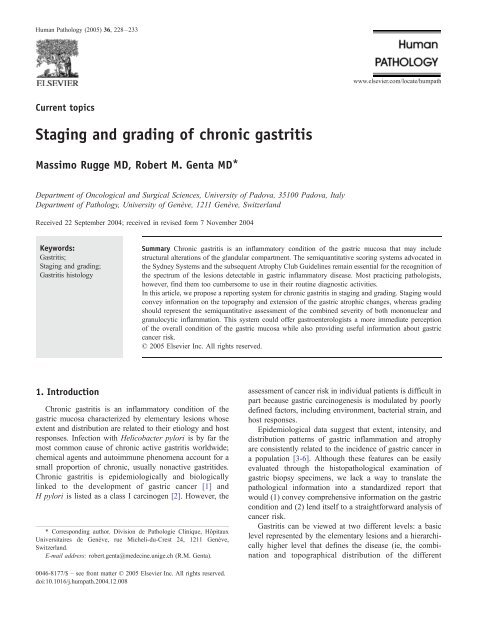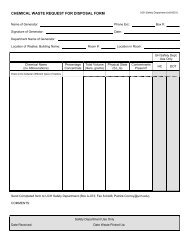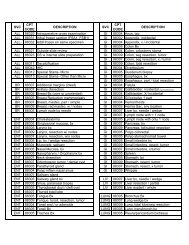Staging and grading of chronic gastritis - Department of Pathology ...
Staging and grading of chronic gastritis - Department of Pathology ...
Staging and grading of chronic gastritis - Department of Pathology ...
Create successful ePaper yourself
Turn your PDF publications into a flip-book with our unique Google optimized e-Paper software.
Human <strong>Pathology</strong> (2005) 36, 228–233www.elsevier.com/locate/humpathCurrent topics<strong>Staging</strong> <strong>and</strong> <strong>grading</strong> <strong>of</strong> <strong>chronic</strong> <strong>gastritis</strong>Massimo Rugge MD, Robert M. Genta MD*<strong>Department</strong> <strong>of</strong> Oncological <strong>and</strong> Surgical Sciences, University <strong>of</strong> Padova, 35100 Padova, Italy<strong>Department</strong> <strong>of</strong> <strong>Pathology</strong>, University <strong>of</strong> Genève, 1211 Genève, Switzerl<strong>and</strong>Received 22 September 2004; received in revised form 7 November 2004Keywords:Gastritis;<strong>Staging</strong> <strong>and</strong> <strong>grading</strong>;Gastritis histologySummary Chronic <strong>gastritis</strong> is an inflammatory condition <strong>of</strong> the gastric mucosa that may includestructural alterations <strong>of</strong> the gl<strong>and</strong>ular compartment. The semiquantitative scoring systems advocated inthe Sydney Systems <strong>and</strong> the subsequent Atrophy Club Guidelines remain essential for the recognition <strong>of</strong>the spectrum <strong>of</strong> the lesions detectable in gastric inflammatory disease. Most practicing pathologists,however, find them too cumbersome to use in their routine diagnostic activities.In this article, we propose a reporting system for <strong>chronic</strong> <strong>gastritis</strong> in staging <strong>and</strong> <strong>grading</strong>. <strong>Staging</strong> wouldconvey information on the topography <strong>and</strong> extension <strong>of</strong> the gastric atrophic changes, whereas <strong>grading</strong>should represent the semiquantitative assessment <strong>of</strong> the combined severity <strong>of</strong> both mononuclear <strong>and</strong>granulocytic inflammation. This system could <strong>of</strong>fer gastroenterologists a more immediate perception<strong>of</strong> the overall condition <strong>of</strong> the gastric mucosa while also providing useful information about gastriccancer risk.D 2005 Elsevier Inc. All rights reserved.1. IntroductionChronic <strong>gastritis</strong> is an inflammatory condition <strong>of</strong> thegastric mucosa characterized by elementary lesions whoseextent <strong>and</strong> distribution are related to their etiology <strong>and</strong> hostresponses. Infection with Helicobacter pylori is by far themost common cause <strong>of</strong> <strong>chronic</strong> active <strong>gastritis</strong> worldwide;chemical agents <strong>and</strong> autoimmune phenomena account for asmall proportion <strong>of</strong> <strong>chronic</strong>, usually nonactive gastritides.Chronic <strong>gastritis</strong> is epidemiologically <strong>and</strong> biologicallylinked to the development <strong>of</strong> gastric cancer [1] <strong>and</strong>H pylori is listed as a class I carcinogen [2]. However, the* Corresponding author. Division de Pathologie Clinique, HôpitauxUniversitaires de Genève, rue Micheli-du-Crest 24, 1211 Genève,Switzerl<strong>and</strong>.E-mail address: robert.genta@medecine.unige.ch (R.M. Genta).assessment <strong>of</strong> cancer risk in individual patients is difficult inpart because gastric carcinogenesis is modulated by poorlydefined factors, including environment, bacterial strain, <strong>and</strong>host responses.Epidemiological data suggest that extent, intensity, <strong>and</strong>distribution patterns <strong>of</strong> gastric inflammation <strong>and</strong> atrophyare consistently related to the incidence <strong>of</strong> gastric cancer ina population [3-6]. Although these features can be easilyevaluated through the histopathological examination <strong>of</strong>gastric biopsy specimens, we lack a way to translate thepathological information into a st<strong>and</strong>ardized report thatwould (1) convey comprehensive information on the gastriccondition <strong>and</strong> (2) lend itself to a straightforward analysis <strong>of</strong>cancer risk.Gastritis can be viewed at two different levels: a basiclevel represented by the elementary lesions <strong>and</strong> a hierarchicallyhigher level that defines the disease (ie, the combination<strong>and</strong> topographical distribution <strong>of</strong> the different0046-8177/$ – see front matter D 2005 Elsevier Inc. All rights reserved.doi:10.1016/j.humpath.2004.12.008
<strong>Staging</strong> <strong>and</strong> <strong>grading</strong> <strong>of</strong> <strong>chronic</strong> <strong>gastritis</strong> 229elementary lesions). Both the 1990 original Sydney System[7] <strong>and</strong> its updated 1994 version (also known as theHouston-updated Sydney System) [8] provided a structureto describe <strong>and</strong> quantify the elementary lesions, that is, theinflammatory cell populations, <strong>and</strong> the accompanyingchanges <strong>of</strong> the epithelial district.Although the Houston-updated Sydney System’s guidelinesare now widely used [9], the interobserver agreementamong pathologists has shown variable levels <strong>of</strong> consistency,particularly with regards to atrophy [10,11]. In an attempt tocorrect this problem, an international group <strong>of</strong> pathologists(Atrophy Club 2000) revisited the spectrum <strong>of</strong> gastricatrophy <strong>and</strong> intestinal metaplasia (IM) [12,13]. A newdefinition <strong>of</strong> atrophy, which includes a metaplastic <strong>and</strong> anonmetaplastic category, was proposed, <strong>and</strong> new criteria forthe 2 main phenotypes <strong>of</strong> <strong>chronic</strong> <strong>gastritis</strong> (nonatrophic <strong>and</strong>atrophic) were established [12,13]. The schema for thisclassification is depicted in Fig. 1. Gastrointestinal pathologistswho tested this classification were able to obtain ahighly satisfactory level <strong>of</strong> interobserver variation [13]. Toour knowledge, no studies regarding the consistency <strong>of</strong>usage <strong>of</strong> the Atrophy Club criteria among general pathologistshave been published to date.As early as 1955, Basil Morson [14] observed that btheincidence <strong>and</strong> the extent <strong>of</strong> IM is greatest in stomachscontaining carcinomas <strong>and</strong> least in those with duodenalulcer, with cases <strong>of</strong> gastric ulcer taking an intermediateposition.Q Later, Pelayo Correa [15,16] demonstrated thatpatchy areas <strong>of</strong> atrophic-metaplastic changes in the antralATROPHYAbsent Indefinite PresentMetaplasticMildModerateSeverenon-MetaplasticMildModerateSevereFig. 1 Classification <strong>of</strong> atrophy proposed by the Atrophy Club2000 (13). The concept <strong>of</strong> babsence <strong>of</strong> appropriate (ie, native to thespecific area) gl<strong>and</strong>sQ introduced in the definition allows theinclusion a metaplastic category, represented by the replacement <strong>of</strong>native gl<strong>and</strong>s by either intestinal-type epithelium or pyloric-typegl<strong>and</strong>s. Non-metaplastic atrophy consists <strong>of</strong> a decreased density <strong>of</strong>native gl<strong>and</strong> units with a corresponding increase in the extragl<strong>and</strong>ularextracellular matrix. These two categories may, <strong>and</strong> <strong>of</strong>tendo, coexist in the same patient. bIndefinite for atrophyQ is apreliminary categorization to be used whenever a dense inflammatoryinfiltrate prevents a clear distinction between the nonatrophic<strong>and</strong> atrophic phenotype.<strong>and</strong> oxyntic mucosa (ie, multifocal atrophic <strong>gastritis</strong>[MAG]) frequently coexisted with gastric ulcer <strong>and</strong> werethe most frequent setting for gastric adenocarcinoma. Onthe basis <strong>of</strong> these <strong>and</strong> other observations [17], the SydneySystems took into account the topographical distribution <strong>of</strong>the elementary lesions in the different gastric compartments<strong>and</strong> recommended that multiple endoscopic biopsysamples be taken from predefined sites <strong>of</strong> the stomach [8].Five main sites were considered necessary: (1) greater <strong>and</strong>lesser curvature <strong>of</strong> the distal antrum (mucus-secretingmucosa), (2) greater <strong>and</strong> lesser curvature <strong>of</strong> the proximalcorpus (oxyntic mucosa), <strong>and</strong> (3) lesser curvature at theincisura angularis, where the earliest atrophic-metaplasticchanges tend to occur [18,19]. The scores <strong>of</strong> theelementary lesions found in individual biopsy samplesare averaged for each gastric compartment <strong>and</strong> used tocharacterize different patterns <strong>of</strong> <strong>gastritis</strong> (eg, antralpredominantnonatrophic, antrum-restricted atrophic).These pattern-based categorizations may allow placingpatients on approximate points <strong>of</strong> the natural history <strong>of</strong><strong>chronic</strong> <strong>gastritis</strong>, from the reversible inflammatory lesions(mostly limited to the antrum) at the one end to theextensive atrophic changes associated with high risk forgastric cancer at the other [4,20-22].This article puts forward a proposal for a systematicapproach to this categorization. Building on our currentunderst<strong>and</strong>ing <strong>of</strong> the morphological alterations <strong>of</strong> <strong>gastritis</strong><strong>and</strong> their evolution, we suggest that—as in <strong>chronic</strong> hepatitis[23,24]—it could be useful to report the phenotypes <strong>of</strong> longst<strong>and</strong>ing<strong>gastritis</strong> in <strong>grading</strong> <strong>and</strong> staging. Grading wouldexpress the cumulative intensity <strong>of</strong> the inflammatorycomponents, whereas staging would convey informationon the anatomical extent <strong>of</strong> the atrophic-metaplastic changesrelated to cancer risk.Self-limiting gastritides, also referred to as acute gastritidesor gastropathies, are a group <strong>of</strong> conditions generallycharacterized by limited inflammatory responses <strong>and</strong> variableerosive <strong>and</strong> hemorrhagic lesions. Most <strong>of</strong>ten caused byenvironmental injury (eg, chemical), they tend to undergorapid recovery after the damaging agents are removed. Suchgastropathies have no known relationship with cancer, <strong>and</strong>therefore, are not included in this discussion.2. The phenotypes <strong>of</strong> <strong>gastritis</strong>Chronic <strong>gastritis</strong> can be atrophic or nonatrophic. Each <strong>of</strong>these two main categories encompasses several clinicopathologicentities with different patterns <strong>of</strong> inflammatory <strong>and</strong>epithelial alterations.2.1. Non-atrophic <strong>gastritis</strong>2.1.1. Antral-predominant non-atrophic <strong>gastritis</strong>This pattern (synonymous with hypersecretory, diffuseantral, or superficial antral <strong>gastritis</strong>) [16] is the mostcommon expression <strong>of</strong> H pylori <strong>gastritis</strong> in the Western
<strong>Staging</strong> <strong>and</strong> <strong>grading</strong> <strong>of</strong> <strong>chronic</strong> <strong>gastritis</strong> 231CORPUSNo Inflammation (G0) Mild Inflammation (G1) Moderate Inflammation (G2) Severe Inflammation (G3)No Inflammation (G0) GRADE 0GRADE IGRADE IIGRADE IIANTRUMMild Inflammation (G1)Moderate Inflammation (G2)GRADE IGRADE IIGRADE IIGRADE IIGRADE IIGRADE IIIGRADE IIIGRADE IVSevere Inflammation (G3)GRADE IIGRADE IIIGRADE IVGRADE IVFig. 2 Grading: intensity <strong>of</strong> the inflammatory cells (lymphocytes, plasma cells, <strong>and</strong> granulocytes) within the lamina propria is graded asabsent (0), mild (1), moderate (2) <strong>and</strong> severe (3) according to the visual analogue scales <strong>of</strong> the Updated Sydney System. The final grade <strong>of</strong>inflammation results from the combination <strong>of</strong> the grades <strong>of</strong> the inflammatory lesions in antral <strong>and</strong> corpus mucosa.epidemiological characteristics. Atrophic pan<strong>gastritis</strong> is themost prevalent setting for both noninvasive <strong>and</strong> invasivegastric neoplasia [26,40,41]. In the stomach, the fieldcancerization process is mucosal atrophy: the atrophic areaswith their metaplastic gl<strong>and</strong>s are the anatomic structuresprone to the phenotypical <strong>and</strong> genotypic alterations leadingto cancer. The field cancerization theory provides therationale for the linear relationship between the extent <strong>of</strong>atrophic changes <strong>and</strong> the risk <strong>of</strong> cancer [42].3. Generating a clinically helpfulhistology reportUsing the framework provided by the Sydney System’s<strong>and</strong> the Atrophy Club’s analytic approach, we havegenerated a proposal for a <strong>grading</strong> <strong>and</strong> staging scheme thatintegrates the relevant histopathological data gathered <strong>and</strong>interpreted by the pathologist <strong>and</strong> delivers them in the form<strong>of</strong> a simple, yet information-rich, report. We submit that hisscheme could do for <strong>chronic</strong> <strong>gastritis</strong> what the <strong>grading</strong> <strong>and</strong>staging <strong>chronic</strong> hepatitis system introduced by the InternationalGroup <strong>of</strong> the Hepatologists has done for <strong>chronic</strong>hepatitis, making prognostically significant <strong>and</strong> reproducibleinformation immediately available in the clinicalpractice [23,24].Grading is a measure <strong>of</strong> the severity <strong>of</strong> the inflammatorylesions. Although other <strong>grading</strong> systems consider separatelythe mononuclear from the neutrophilic infiltrate, there is noevidence that this distinction is clinically relevant. Wepropose that <strong>grading</strong> should represent the semiquantitativeassessment <strong>of</strong> the combined severity <strong>of</strong> mononuclear <strong>and</strong>CORPUSNo Atrophy(score 0)Mild Atrophy(score 1)Moderate Atrophy(score 2)Severe Atrophy(score 3)ANTRUMNo Atrophy (score 0)(including incisura angularis)Mild Atrophy (score 1)(including incisura angularis)Moderate Atrophy (score 2)(including incisura angularis)STAGE 0 STAGE I STAGE II STAGE IIISTAGE I STAGE II STAGE II STAGE IIISTAGE II STAGE II STAGE III STAGE IVSevere Atrophy (score 3)(including incisura angularis)STAGE IIISTAGE IIISTAGE IVSTAGE IVFig. 3 <strong>Staging</strong>: atrophy is defined as loss <strong>of</strong> appropriate gl<strong>and</strong>s (with or without IM). In each compartment (ie, mucous-secreting antral <strong>and</strong>oxyntic/corpus mucosa), atrophy is scored in a 4 tiered scale (0-3), according to the visual analogue scale <strong>of</strong> the Updated Sydney System.
232granulocytic inflammation scored in both antral <strong>and</strong> oxynticbiopsy samples. Grades range from 0 (absence <strong>of</strong> inflammatorycells in any <strong>of</strong> the specimens) to 4 (a very denseinfiltrate in all the biopsy samples) (Fig. 2).<strong>Staging</strong> refers to the extent <strong>of</strong> atrophy with or withoutIM. The stage <strong>of</strong> <strong>chronic</strong> <strong>gastritis</strong> is related to both itsduration <strong>and</strong> to the host’s response to the etiologicalagent(s) <strong>and</strong> may have implications for the prognosis <strong>and</strong>management <strong>of</strong> the patient. Some studies suggested that thehistochemical phenotype <strong>of</strong> IM is associated with a cancerrisk increasing progressively from type I to type III [43,44].Because a greater extension <strong>of</strong> metaplasia is associatedwith a greater proportion <strong>of</strong> type III IM [40], we uphold therecommendation <strong>of</strong> the Updated Sydney System discouragingthe use <strong>of</strong> histochemical phenotyping to determinethe type <strong>of</strong> metaplasia. Atrophy should be assessed usingthe histological criteria detailed by the Atrophy Club,which have been validated <strong>and</strong> shown to be reproducible[13]. Fig. 3 shows how the scores from antral <strong>and</strong> oxynticmucosal biopsy sites can then be combined <strong>and</strong> reportedusing a scale ranging from 0 (absence <strong>of</strong> atrophy <strong>and</strong>metaplasia) to 4 (pan-atrophy involving all antral <strong>and</strong>oxyntic samples).4. ConclusionsThe article reporting the Updated Sydney System,published in October 1996, has recently reached the1000-citation milestone [9], indicating that the semiquantitativescoring system it advocated remains a useful tool forclinical research. Nevertheless, the very same pathologistswho use it when assessing biopsies for clinical studies findit too cumbersome to use in their routine diagnosticactivities. We suggest that the method proposed here isboth feasible <strong>and</strong> practical. When a satisfactory set <strong>of</strong>gastric biopsies is available, staging <strong>and</strong> <strong>grading</strong> (precededby a description <strong>of</strong> the histological findings in the biopsysamples) could represent the concluding message <strong>of</strong> thehistological report.An initial informal testing <strong>of</strong> this proposed scheme hasbeen well received by gastroenterologists in our respectiveinstitutions. Once accepted <strong>and</strong> disseminated, it could <strong>of</strong>ferclinicians an overall perception <strong>of</strong> the gastric disease, whilealso providing potentially useful information about cancerrisk. Ten years ago, a similar nomenclature was proposedfor reporting <strong>chronic</strong> hepatitis. Tested in the routine practice<strong>and</strong> now used by virtually all hepatopathologists, staging<strong>and</strong> <strong>grading</strong> have been proven to be both reproducible <strong>and</strong>clinically useful. Our hope is that this proposal stimulates aconstructive debate <strong>and</strong> that this scheme can eventually betested in a variety <strong>of</strong> clinicoepidemiological settings todetermine (1) whether pathologists can use it with asatisfactory interobserver consistency <strong>and</strong> (2) whether theprognostic value that we have hypothesized can beconfirmed in the field.ReferencesM. Rugge, R.M. Genta[1] Correa P. A human model <strong>of</strong> gastric carcinogenesis. Cancer Res1988;48:3554-60.[2] Anonymous. Schistosomes, liver flukes <strong>and</strong> Helicobacter pylori.IARC Working Group on the evaluation <strong>of</strong> carcinogenic risks tohumans. Lyon, 7-14 June 1994. IARC Monogr Eval Carcinog RisksHum 1994;61:1-241.[3] Correa P, Cuello C, Duque E, et al. Gastric cancer in Colombia. III.Natural history <strong>of</strong> precursor lesions. J Natl Cancer Inst 1976;57:1027-35.[4] Sipponen P, Kekki M, Siurala M. Atrophic <strong>chronic</strong> <strong>gastritis</strong> <strong>and</strong>intestinal metaplasia in gastric carcinoma. Comparison with arepresentative population sample. Cancer 1983;52:1062-8.[5] You WC, Zhang L, Gail MH, et al. Precancerous lesions in twocounties <strong>of</strong> China with contrasting gastric cancer risk. Int J Epidemiol1998;27:945-8.[6] Correa P. The biological model <strong>of</strong> gastric carcinogenesis. IARC SciPubl 2004;301- 10.[7] Price AB. The Sydney system: histological division. J GastroenterolHepatol 1991;6:209- 22.[8] Dixon MF, Genta RM, Yardley JH, et al. Classification <strong>and</strong> <strong>grading</strong> <strong>of</strong><strong>gastritis</strong>. The updated Sydney system. International workshop on thehistopathology <strong>of</strong> <strong>gastritis</strong>, Houston 1994. Am J Surg Pathol1996;20:1161-81.[9] ISI web <strong>of</strong> science—Citation Index. Science Citation Index Exp<strong>and</strong>ed(SCI-EXPANDED)-1945-present. 2004.[10] Offerhaus GJ, Price AB, Haot J, et al. Observer agreement on the<strong>grading</strong> <strong>of</strong> gastric atrophy. Histopathology 1999;34:320-5.[11] Aydin O, Egilmez R, Karabacak T, et al. Interobserver variation inhistopathological assessment <strong>of</strong> Helicobacter pylori <strong>gastritis</strong>. World JGastroenterol 2003;9:2232-5.[12] Ruiz B, Garay J, Johnson W, et al. Morphometric assessment <strong>of</strong>gastric antral atrophy: comparison with visual evaluation. Histopathology2001;39:235-42.[13] Rugge M, Correa P, Dixon MF, et al. Gastric mucosal atrophy:interobserver consistency using new criteria for classification <strong>and</strong><strong>grading</strong>. Aliment Pharmacol Ther 2002;16:1249-59.[14] Morson BC. Intestinal metaplasia in the gastric mucosa. Br J Cancer1955;9:365 - 76.[15] Correa P. The epidemiology <strong>and</strong> pathogenesis <strong>of</strong> <strong>chronic</strong> <strong>gastritis</strong>:three etiologic entities. Front Gastrointest Res 1980;6:98-108.[16] Correa P. Chronic <strong>gastritis</strong>: a clinico-pathological classification. Am JGastroenterol 1988;83:504-9.[17] Sugimura T, Sugano H, Terada M, et al. First international workshop<strong>of</strong> the Princess Takamatsu cancer research fund: intestinal metaplasia<strong>and</strong> gastric cancer. Mol Carcinog 1994;11:1-7.[18] Kimura K. Chronological transition <strong>of</strong> the fundic-pyloric borderdetermined by stepwise biopsy <strong>of</strong> the lesser <strong>and</strong> greater curvatures <strong>of</strong>the stomach. Gastroenterology 1972;63:584- 92.[19] Rugge M, Cassaro M, Pennelli G, et al. Atrophic <strong>gastritis</strong>:pathology <strong>and</strong> endoscopy in the reversibility assessment. Gut 2003;52:1387-8.[20] Sipponen P, Kekki M, Haapakoski J, et al. Gastric cancer risk in<strong>chronic</strong> atrophic <strong>gastritis</strong>: statistical calculations <strong>of</strong> cross-sectionaldata. Int J Cancer 1985;35:173-7.[21] Sipponen P, Seppala K, Aarynen M, et al. Chronic <strong>gastritis</strong> <strong>and</strong>gastroduodenal ulcer: a case control study on risk <strong>of</strong> coexistingduodenal or gastric ulcer in patients with <strong>gastritis</strong>. Gut 1989;30:922-9.[22] Sipponen P, Riihel7 M, Hyv7rinen H, et al. Chronic non-atrophic(dsuperficialT) <strong>gastritis</strong> increases the risk <strong>of</strong> gastric carcinoma. A casecontrolstudy. Sc<strong>and</strong> J Gastroenterol 1994;29:336-40.[23] Desmet VJ, Gerber M, Ho<strong>of</strong>nagle JH, et al. Classification <strong>of</strong> <strong>chronic</strong>hepatitis: diagnosis, <strong>grading</strong><strong>and</strong>staging.Hepatology1994;19:1513-20.[24] Ishak K, Baptista A, Bianchi L, et al. Histological <strong>grading</strong> <strong>and</strong> staging<strong>of</strong> <strong>chronic</strong> hepatitis. J Hepatol 1995;22:696-9.
<strong>Staging</strong> <strong>and</strong> <strong>grading</strong> <strong>of</strong> <strong>chronic</strong> <strong>gastritis</strong> 233[25] Graham DY. Helicobacter pylori infection in the pathogenesis <strong>of</strong>duodenal ulcer <strong>and</strong> gastric cancer: a model. Gastroenterology1997;113:1983-91.[26] Miehlke S, Hackelsberger A, Meining A, et al. Severe expression <strong>of</strong>corpus <strong>gastritis</strong> is characteristic in gastric cancer patients infected withHelicobacter pylori. Br J Cancer 1998;78:263-6.[27] Genta RM. Recognizing atrophy: another step toward aclassification <strong>of</strong> <strong>gastritis</strong>. Am J Surg Pathol 1996;20(Suppl 1):S23-S30.[28] Strickl<strong>and</strong> RG, Mackay IR. A reappraisal <strong>of</strong> the nature <strong>and</strong>significance <strong>of</strong> <strong>chronic</strong> atrophic <strong>gastritis</strong>. Am J Dig Dis 1973;18:426-40.[29] Capella C, Fiocca R, Cornaggia M, et al. Autoimmune <strong>gastritis</strong>.In: Graham DY, Genta RM, Dixon MF, editors. Gastritis.Philadelphia7 Lippincott Williams & Wilkins; 1999. p. 79-96.[30] Yang GY, Zhang YC, Liu XD, et al. Geographic pathology on theprecursors <strong>of</strong> stomach cancer. J Environ Pathol Toxicol Oncol 1992;11:339-44.[31] Genta RM, Gqrer IE, Graham DY. Geographical pathology <strong>of</strong>Helicobacter pylori infection: is there more than one <strong>gastritis</strong>? AnnMed 1995;27:595-9.[32] El Zimaity HMT, Gutierrez O, Kim JG, et al. Geographic differencesin the distribution <strong>of</strong> intestinal metaplasia in duodenal ulcer patients.Am J Gastroenterol 2001;96:666-72.[33] Kimura K. Gastritis <strong>and</strong> gastric cancer. Asia. Gastroenterol Clin NorthAm 2000;29:609- 21.[34] Kuipers EJ, Meijer GA. Helicobacter pylori <strong>gastritis</strong> in Africa. Eur JGastroenterol Hepatol 2000;12:601-3.[35] Segal I, Ally R, Mitchell H. Gastric cancer in sub-Saharan Africa.Eur J Cancer Prev 2001;10:479- 82.[36] Rugge M, Le<strong>and</strong>ro G, Farinati F, et al. Gastric epithelial dysplasia.How clinicopathologic background relates to management. Cancer1995;76:376-82.[37] Meister H, Holubarsch C, Haferkamp O, et al. Gastritis, intestinalmetaplasia <strong>and</strong> dysplasia versus benign ulcer in stomach <strong>and</strong>duodenum <strong>and</strong> gastric carcinoma—a histotopographical study. PatholRes Pract 1979;164:259-69.[38] Sipponen P. Natural history <strong>of</strong> <strong>gastritis</strong> <strong>and</strong> its relationship to pepticulcer disease. Digestion 1992;51(Suppl 1):70-5.[39] Skinner JM, Heenan PJ, Whitehead R. Atrophic <strong>gastritis</strong> ingastrectomy specimens. Br J Surg 1975;62:23- 5.[40] Cassaro M, Rugge M, Gutierrez O, et al. Topographic patterns <strong>of</strong>intestinal metaplasia <strong>and</strong> gastric cancer. Am J Gastroenterol 2000;95:1431-8.[41] Meining A, Bayerdorffer E, Muller P, et al. Gastric carcinoma riskindex in patients infected with Helicobacter pylori. Virchows Arch1998;432:311 - 4.[42] Garcia SB, Park HS, Novelli M, et al. Field cancerization, clonality,<strong>and</strong> epithelial stem cells: the spread <strong>of</strong> mutated clones in epithelialsheets. J Pathol 1999;187:61- 81.[43] Filipe MI, Munoz N, Matko I, et al. Intestinal metaplasia types <strong>and</strong> therisk <strong>of</strong> gastric cancer: a cohort study in Slovenia. Int J Cancer1994;57:324-9.[44] Wu MS, Shun CT, Lee WC, et al. Gastric cancer risk in relation toHelicobacter pylori infection <strong>and</strong> subtypes <strong>of</strong> intestinal metaplasia.Br J Cancer 1998;78:125-8.






